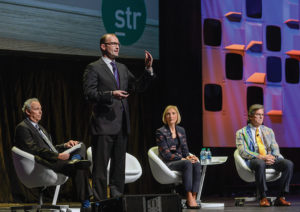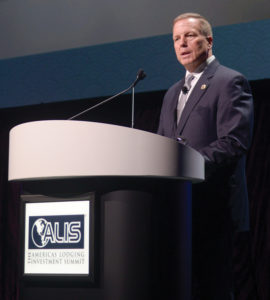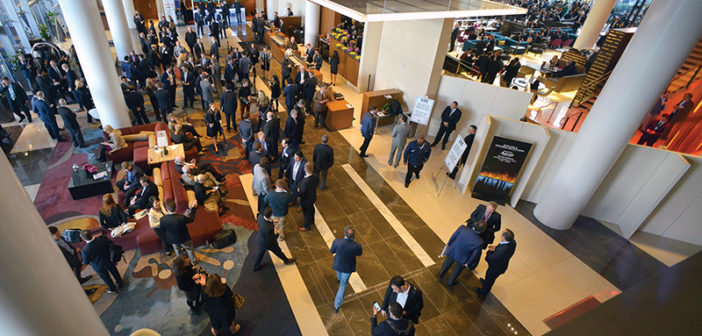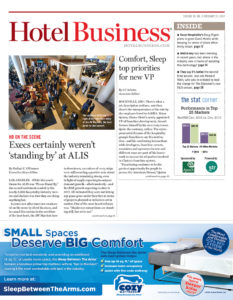LOS ANGELES—While this year’s theme for ALIS was “Please Stand By,” the overall sentiment exuded by the nearly 3,000 hospitality industry movers and shakers was that they are doing anything but.
In interview after interview conducted on the scene by Hotel Business, and in casual discussions in the corridors of the host hotel, the JW Marriott here in downtown, executives of every stripe were still sounding a positive note about the industry remaining strong, even in light of supply expecting to outpace demand growth—albeit modestly—and RevPAR growth expecting to slow in 2017. All indicated they were not letting any grass grow under their feet in terms of projects planned or initiatives set in motion. One of the most heard refrains was: “Maybe our competitors are standing still, but we’re not.”
The annual event, formally known as The Americas Lodging Investment Summit, traditionally sets the tone for the industry outlook, although that does not appear to be the overall case this year.
What did stick to the script was the silly skit historically mounted as part of the opening session. Almost-Emmy contenders on the boards this year were Amanda Hite, STR president/CEO; Scott D. Berman, principal and U.S. industry leader, hospitality and leisure, PwC; and R. Mark Woodworth, senior managing director, CBRE Hotels’ Research, who was appropriately garbed in a jacket reminiscent of a SMPTE color bar television test pattern. Each played buzz(er)-worthy contestants on a Sixties-style game show targeting hotels of the future. The “show” was sponsored by Hotel Innovations, whose most memorable product—shown in glorious black and white—was a “Magic Fingers Motor,” basically guaranteed to improve RevPAR for properties putting them under existing mattresses, according to MFM huckster and demonstrator, Bob “I’m So Relaxed” Alter, president of Seaview Investors LLC.

STR’s SVP Jan Freitag makes a point during discussion on industry fundamentals. Pebblebrook Hotel Trust Chairman/CEO Jon E. Bortz (left) moderated the panel, which included Suzanne R. Mellen, senior managing director, HVS, and R. Mark Woodworth, senior managing director, CBRE Hotels’ Research.
The tongue-in-cheek takeaway proffered robots will be great since they don’t complain and hoteliers can stop worrying about millennials, since they’ll never leave their parents’ homes long enough to travel.
Jim Burba, chairman of ALIS and president of BHN, which hosts the event along with the American Hotel & Lodging Association (AHLA), explained the reasoning behind this year’s Summit theme.
“When we were planning this conference last summer, in talking to the planning committee, it was: ‘What do you think is going to happen? What’s the cycle? Where are we? And the proverbial what inning of the baseball game are we in? When does this end?’ This has been the longest, protracted—albeit not always glamorous—growth that we’ve had since the recession in my memory. In 2008-2009, it was pretty bad, as everybody knows, but it’s been pretty okay ever since then. So, the question was: ‘When does this end?’ So, we came up with the theme ‘Please Stand By’ because we don’t know. We didn’t know how pertinent ‘Please Stand By’ would be given the political changes that happened in this country because now we’re standing by on a lot of those.”
AHLA Chairman Mark Carrier, president of B.F. Saul Co. Hospitality Group, gave updates on the association’s activities, noting it is addressing one of the industry’s key concerns.
“From coast to coast, the AHLA is working with a very broad-based coalition, including housing advocates and neighborhood groups, to address and rein in the unregulated and illegal hotels that have been facilitated through short-term, online rental platforms,” said Carrier.
In addition, he said AHLA achieved “important” congressional action last year through legislation to stop online booking scams by introducing bills in both the House and Senate. “I can tell you from being engaged in that up front the professionals of our team are really on game as it relates to this issue,” said Carrier.

AHLA Chairman Mark Carrier, president of B.F. Saul Co. Hospitality Group, detailed the association’s activities and growth for ALIS attendees.
To get a sense of the dynamics behind the current political landscape, Katherine Lugar, AHLA’s president/CEO, interviewed CNN Senior Political and Election Analyst Ron Brownstein, who also serves as political director for Atlantic Media Co. and is editorial director and columnist for National Journal. The pundit indicated the political picture was not due to an “overnight” shift in values or the presidential candidates’ tactical weaknesses.
“I think it is better to understand this election as the intensification of the ongoing separation and realignment that we have been living through since the election of 2000, at least,” said Brownstein. “Essentially, if you look back over the past 20-25 years, what we’ve seen develop is a democratic coalition that is younger, more diverse, increasingly white collar, secular and overwhelmingly urbanized. And a Republican coalition that remains preponderantly white, is older, more blue collar, more religious and heavily non-urban. This election took all of those trends and turned them up to 11 as they said in [the 1984 mockumentary]This is Spinal Tap. But what happened was Donald Trump consolidated his side of the line just a little bit more than Hillary Clinton did.”
Marriott International President/CEO Arne Sorenson was one of three major franchise company executives to deliver a 10-minute “Spotlight” presentation during the opening session, peering into the future to examine “Travel Tomorrow and in 2030.”
“We continue to see a growing economy and with that, obviously growing demand for our hotels, but beyond that we see a number of profound macro-trends that are making our business more and more exciting,” noted the CEO.
He cited the growth of the global middle class, the collection of experiences instead of things, and the “incredible pace of change” vis-à-vis technology.
“It is an exciting time and the future is really something to be optimistic about,” said Sorenson, albeit noting there are still contemporary concerns that need to be addressed.
“It’s clear that today the biggest frustration is about the difficulty of travel,” he said, stressing the need for technologically updated and more-streamlined processes, particularly around security and immigration. He also felt technology can be utilized to further evolve the welcome and experience aspects of a hotel stay, e.g., greater use of keyless entry or room-amenity customization.
“I think increasingly we will see the loyalty program is the platform by which we get to know our customers and by which we get to provide, even through technological tools, a welcome that is nearly unique to them,” said Sorenson, adding a similar approach could be taken with the hotel experience. “We’ve got to make sure that we use technology to build a way for people to get these experiences that are one-of-a-kind, local and unique.”
Other industry leaders in the “Spotlight” included Hilton President/CEO Christopher J. Nassetta, who spoke on “The Future of Youth in Hospitality,” and Carlson Hospitality Group’s then-CEO David Berg, who looked at “Industry Consolidation.”
A panel discussion on industry fundamentals was moderated by Pebblebrook Chairman/CEO Jon Bortz and included Jan Freitag, SVP of STR; Suzanne R. Mellen, senior managing director, HVS; and CBRE’s R. Mark Woodworth.
Freitag noted 2016 RevPAR growth came in at 3.2% and this year, supply and demand are going to be “in imbalance in favor of supply growth, so occupancies will actually be declining. That is still made up by growth in ADR, so RevPAR growth for the foreseeable future is still going to be positive. Through December of last year, RevPAR was in its 82nd month of consecutive growth and we don’t really see that changing very much.” He drew a similar picture for the Canadian hotel industry, noting RevPAR growth is “still healthy, but slowing.”
HVS’ Mellen observed cap rates, which have been picking up over the past few years “will continue to rise modestly in 2017, primarily due to interest rates and also the slowing of RevPAR and net income growth… We expect the cap-rate rise on limited-service, midscale up through upper-scale select-service hotels will probably see the highest rise in cap rates due to the threat of new supply, which is kind of creating a gap between buyer and seller expectations. We think there’s potential in the full-service and luxury side; high-quality assets may actually see cap rates decline slightly.”
In its coverage of 60 of the largest domestic U.S. markets, CBRE’s Woodworth presented two scenarios: markets that in 2016 experienced a net increase in supply growth greater than 2% [the long-run average national change]and those markets that fell below that threshold.
“If you look at the occupancy levels within those two buckets, there’s really not a lot of difference, but what’s probably not that surprising, if you look at the change in RevPAR between the two, you very clearly begin to see the consequences of high levels of supply growth in those markets that have gone through that,” explained Woodworth. He noted that in 2017, the 21 markets that had supply growth above 2% in 2016 had more than doubled, growing to 46 markets.
Catch up on what else leading executives had to say at ALIS. Watch our interviews with industry executives at hotelbusiness.com. HB
Watch video coverage at video.hotelbusiness.com


